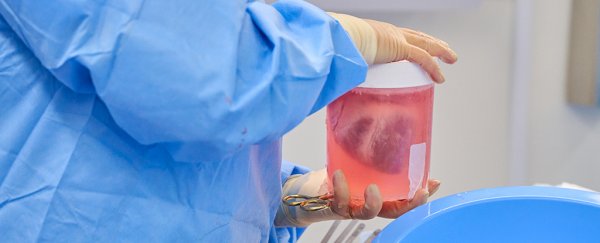Two genetically modified pig hearts were just successfully transplanted into humans, in what is the second major move forward for pig-human heart xenotransplantation this year.
"It was one of the most incredible things, to see a pig heart pounding away and beating inside a human chest," Dr. Robert Montgomery, director of NYU Langone Transplant Institute where the transplantations took place, said during a press conference on Tuesday.
One of the transplantations took place in mid-June, and the other was completed on July 6.
But there's a catch. The two transplant patients were people who were already brain-dead, whose hearts were kept beating on ventilators in order to receive the pig organs. It will likely take years before pig-to-human transplant procedures could become routine, reliable options for people on long waiting lists for hearts, kidneys, and other vital organs.
"There will be an iterative process of learning, changing tactics," said Montgomery, who is a heart transplant recipient himself.
Still, the doctor harbors hope that pig organs could one day become a "renewable, sustainable source of organs, so no one will have to die waiting."
More human trials could become reality in the next few years
The first known pig-human heart transplant into a living patient was completed at the University of Maryland in January. That transplant was for a 57-year-old man with life-threatening heart disease.
"It was either die, or do this transplant," the patient, David Bennett Sr, said a day before his surgery. "I know it's a shot in the dark, but it's my last choice."
Bennett's new pig heart failed two months later. The DNA of a pig virus was later discovered in the heart, but there was no evidence of an active infection, the surgeon behind that procedure told The New York Times.
"We don't really know why that heart failed and why he died," Montgomery said. That, he argues, is why it's important to continue doing research on deceased donors, before moving forward with more live xenotransplantation trials.
 The removed human heart. (Joe Carrotta/NYU Langone Health)
The removed human heart. (Joe Carrotta/NYU Langone Health)
"This is a huge, huge step in the right direction," Dr. Chris Colbert, an ER doctor from Chicago, who was not involved in the research, told Insider after hearing the news. "It's not just an organ, but an organ match."
The two pig hearts transplanted at NYU this summer were able to function for at least 72 hours inside human bodies because they were engineered with 10 genetic modifications. Four of the gene edits were porcine, to prevent transplant rejection and abnormal growth, and six were human transgenes, designed to make human and pig parts more compatible.
"It really is the next frontier in transplant medicine," Dr. Preethi Pirlamarla, a heart transplant cardiologist at Mount Sinai in New York, who was not involved in the NYU research, told Insider. "It's really just a modern miracle that we're even able to consider this."
Routine pig-to-human heart transplants could be 'very possible' within a decade
Prilamarla says before pig-human heart transplants can become routine, doctors will need to better understand how to make modified pig organs more compatible inside living, moving human bodies, so they won't be rejected by the recipients. Researchers and surgeons will also need to ensure "we don't transmit some unforeseen infection that would be in the pig, that would then get transmitted along to the human," she added.
But, she also said she wouldn't be surprised if pig-to-human heart transplants became commonplace within her career.
"Do I see it happening in the next year? I don't think so," she said. "Do I see it coming down the line 5, 10 years? I think it is very possible."
Heart disease is the number one killer in the US, and demand for heart transplants is high.
There are other things, besides genetically modified pig hearts, that could be done to cut wait times for vital organs. Bipartisan members of Congress are already calling for "long overdue" overhauls of the "underperforming" and even "failing" federal Organ Procurement Organizations, which are responsible for doling out organs nationwide.
This article was originally published by Business Insider.
More from Business Insider:
